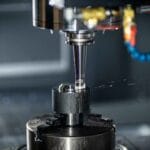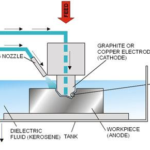Introduction
CAM- stands for Computer Aided Manufacturing in design but this can also be preferred as the meaning of computer aided machining or computer aided modelling.
In the area of digital production, it rolls out very efficient means to control the computer system in manufacturing. Computer aided manufacturing has control over the software basis production machines like CNC/DNC. It prepares its instructions with the help of a designer on designing software in the form of G-code or M-code. These codes are nothing but a normal text file.
In the current market, it is very challenging for every organization to make their own value, and if they are not eligible to give something new for their customer and product quality which is capable to satisfy the customer, the industry can’t grow up and will never achieve its goal and can suffer by economical lag.

In early days 3D printing has come into knowledge and many organizations started to work on it and to explore its ability as well as a functional area. This is capable manufacturing of mechanical components without assembly so, in short, it can prepare assembled products in a single time. For the same product if we go for a traditional manufacturing process, we have to create parts first and then have to assemble them for taking work from them but by the use of 3D printing final product can be made. It saves time, labor, as well as the cost of the product.
So if at the right time the organization does not come with the new and attractive products, others can beat them and will overtake.
History
Before 50thdecade there were no appropriate technology that is able to work on artificial intelligence (AI) basis. It was like a dream that machines will perform the manufacturing process as a human being does. But as days as passed technology makes an approach in different areas. About 60th decade few automobile industries like Renault have started to work on CAM type software.
It was the early days when machines were started to work on the basis of the program. At this time humans and machines were not familiar with each other so it creates many difficulties to operate the machine in the absence of artificial intelligence. It was very necessary to take care of and attentive while operating machines. Production becomes stopped due to a single mistake occurs in the program and also need manual checking to run the program. G – code is needed in the manner to continue the production process. This is a simple text file of the program.
In these days manufacturing were concentrated only on limited features like in….
- 1970 –Cost focused
- 1980 –Quality focused
- 1990 –Delivery performance, customisation, environmental issues
- 2000 – Information and knowledge integration.
There was much more need for development in CAM and CNC machines. The issue in G-code, create lots of restrictions in small production run and prototypes.
On the integration of many Softwares like CAD/CAM/CAE the final product comes out as goods. The output comes from the CAM are usually known as G-code/ M-code which is simply text file read by DNC’s, which is well known as for manufacturing of goods.
Also Read:
- What is Slotter Machine?
- What is Lathe Machine? Main parts, Operations and Working
- What is Mechatronics and Mechatronics Engineering?
Manufacturing
This is the process in which raw material becomes change into finished goods by means of supplying energy and adding values.
This made changes into input material as the requirement and gives the product on the behalf of the application implemented on the input material. Manufacturing can be in the form of soft data or physical objects. It is not necessary that in manufacturing, the final product will be physically used.
Manufacturing process have been classified in many types on the basis of the operation, but there are two main types-
- Continuous manufacturing
- Part discrete type
Continuous manufacturing-
Under this type of manufacturing, those processes categorized which work continuously towards production. Most of the operations conveyed on the alloy steel, ceramics and glasses come in this type of manufacturing. Highly qualified and automated types of machinery are used for continuous manufacturing.
Part Discrete Type –
Most of the complicated designs are made in different types of parts which further joined by means of assembly. So those components can’t made by the continuous production process. This becomes time-consuming but the product comes out is very effective and fulfills the expectations. Most of mechanical, electrical products prepared through this mechanism.
Design for Manufacturing
The product through CAM-Computer aided manufacturing technology is going to prepare by automated machines so the automated machines need instructions and on that basis, they will perform their operation.
In this process, a soft model of the product being prepared by using analysis and optimization can occur. This offers to check the property of the final product and how much valuable utilization will be received in the final physical result.
So the designing skill scrolls out the most valuable term to make the manufacturing process more effective and efficient. They decide to give different allowances like tolerance, machining, and shaping, etc. If allowances didn’t consider with proper dimension the final product can break.
Therefore these points indicate that designing the component must be in good manners and it’s a basic necessary step of manufacturing which plays the most important role for a good product.
Also Read:
- 6 Types of Screwdrivers – Everyone Must Know
- 24 Most Common Types of Pliers and Their Uses (With Pictures)
- 37 Types of Hammers that You Don’t Know?
Automation

Automation is a very old process which has been started from about 1940 when milling and shaping machines were working for multi-head cutting operation. But those machines were not much able in comparison to modern machines. It was very difficult to handle them also. After the digitalization and invention of new technologies very fresh features become added. After introducing artificial intelligence, machines comes with lot of potentials and it reduces human efforts. Nowadays machines do not need much manpower. They all are fully automated and self controled.
There are two types of automation comes into know-
Fix Automation
Under this category those operations considered which are continually used for huge production. As it has clearly an indication that it is difficult to make it mobile. It can manufacture products for a long time after starting for a single time.
These machines contain more machine parts so it requires high initial investment to start the manufacturing. Investment is high so the output will also more in result and the benefits will also be more. They don’t need much caring.
Flexible Automation
This is a program based manufacturing process and it does not need huge manpower. Once the program of operation is fed in the machine, it starts its operation on the workpiece automatically. With the help of these it is very easy to make changes and implementation of new ideas on the workpiece. This type of automation can not be used for a long time. These are specially used for critical and expensive production where very accurate dimensions needed. The production rate is low as compared to fixed automation. Production can be started with the less initial cost.
Concept of Automation
Automation meant for, something that is able to run by itself. This means that it can perform work automatically and no need of human efforts. The effort should either be physical or mental, not used. So considering these points automation have been divided into two types-
Fully Automated
In this the machines are able to instruct by their own intelligence, they don’t need any external instruction. They operate automatically by means of artificial intelligence. This reduced human efforts and save time. The production rate is much high.
Partly Automated
Machines run automatically but they do not have their own intelligence power. There is a need for instruction of the human mind to perform an operation. Production is lesser than fully automatic but its cost is lower than that is fully automated.








